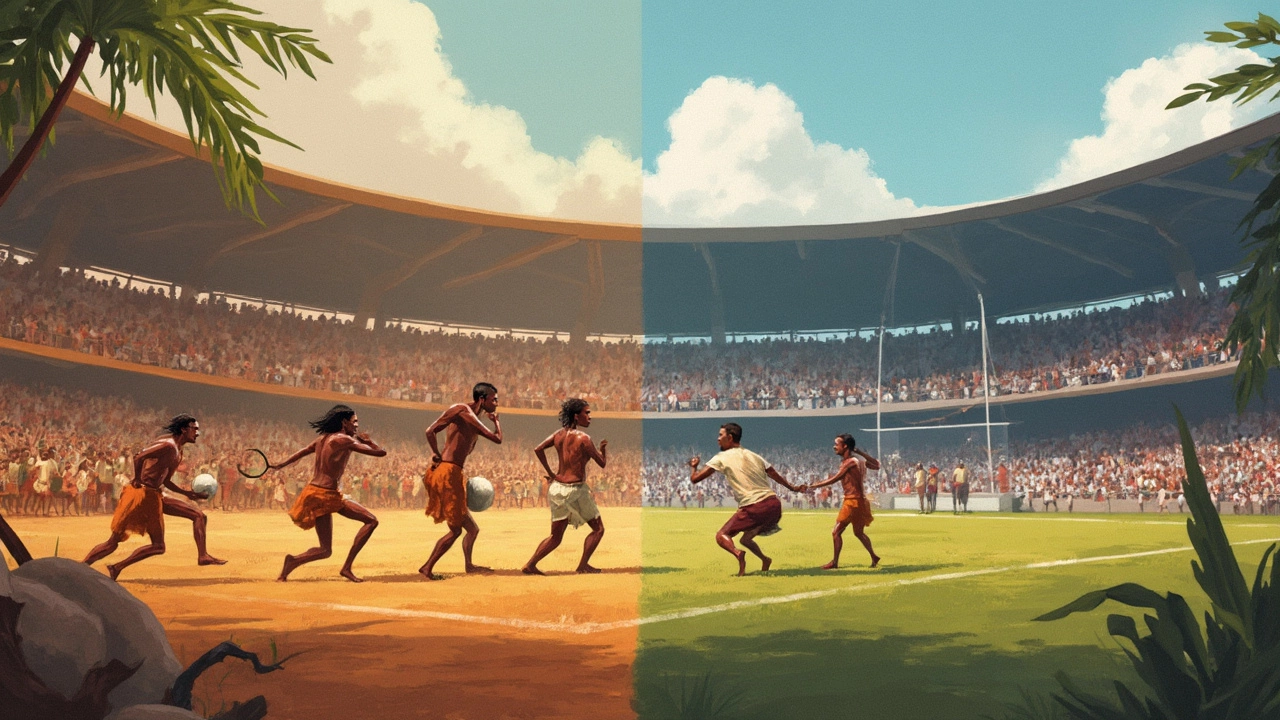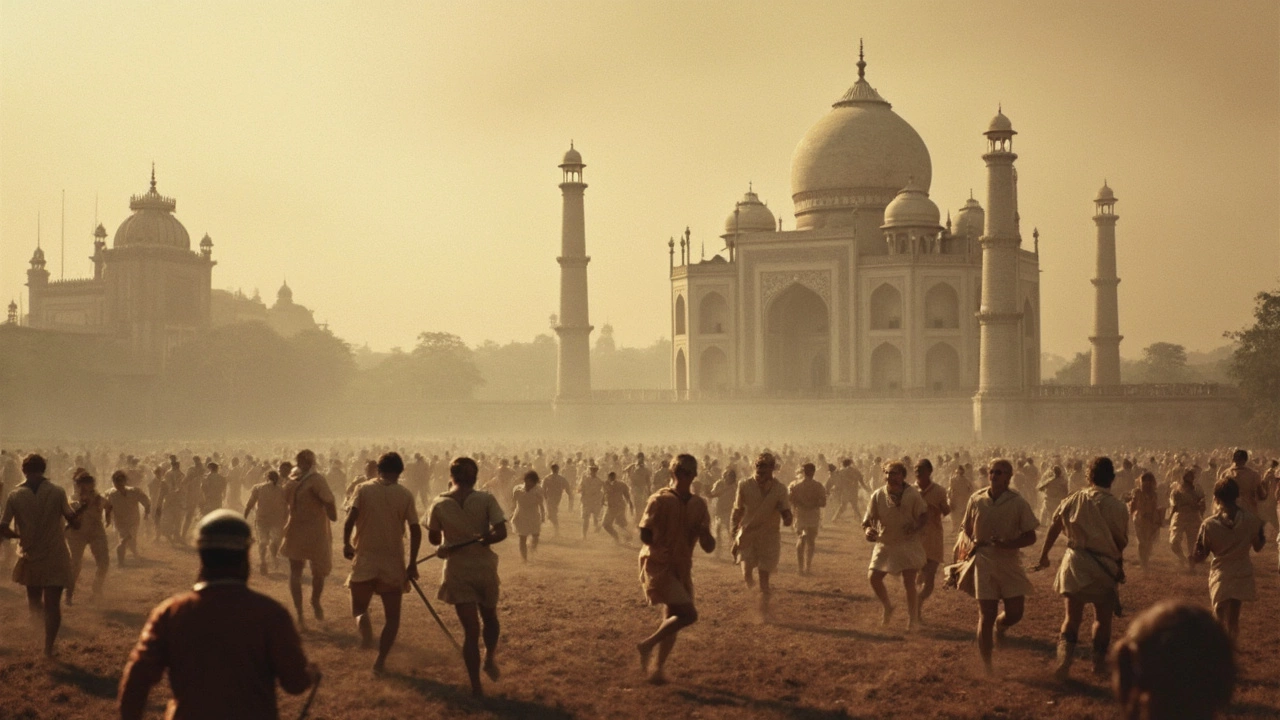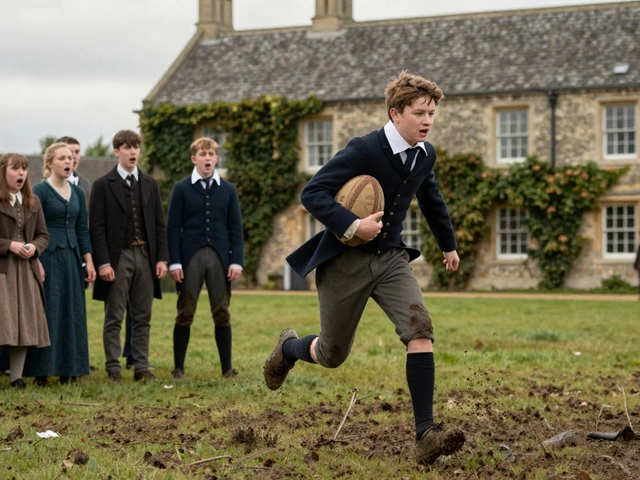Ever argued with a friend about whether rugby or football came first? You're not alone. These sports are tangled in history like twins. But let's set the record straight.
Rugby and football both originate from the same root—the mob games played across medieval Europe. No rules, a lot of chaos, and as you can guess, plenty of fun. Yet, it was in the 19th century that things got interesting. Schools and clubs started formalizing the rules, making them two separate sports.
Now, here’s something to chew on: the Football Association was established in 1863 in England, setting the ball rolling for 'soccer', while rugby took shape with the Rugby Football Union in 1871. This timeline might make football appear older, but remember, the Rugby World Cup now rivals the FIFA World Cup in global viewership. Quite a turnaround, isn't it?
- The Birth of Rugby and Football
- Common Misconceptions
- Historical Records and Evidence
- Parallel Evolutions in the 19th Century
- Influence on Modern Fixtures
- Spotlight on Lesser-Known Facts
The Birth of Rugby and Football
When we talk about the origins of rugby and football, it's like going back in time to the playgrounds of history. Both sports sprang from the traditional ball games that were played across European fairs and festivals. But the real story of their emergence as distinct sports starts in the 19th century.
Back in the day, schools in England had slightly different ways of playing what they called 'football'. It wasn't just about kicking the ball; handling and running were also in the mix. Two key schools, Rugby School and Eton College, had different approaches. At Rugby School, picking up the ball and running with it was not only allowed, it was celebrated.
Setting the Ground Rules
The big split happened in 1863 when the Football Association (The FA) was formed. They wanted to establish a unified set of rules, and thus modern 'soccer' was born. But enthusiasts of the Rugby School style felt otherwise. They were determined to keep the physical, hand-driven aspect, which led to the birth of the Rugby Football Union in 1871.
From Playground to Pitch
As schools and clubs got more organized, the sports began to spread. Rugby gained popularity not only in England but also in countries like New Zealand and South Africa. Meanwhile, what we now call soccer started to gain traction globally, especially in Europe and South America.
No discussion of these games' roots would be complete without mentioning the massive turnouts and passions they ignite today. Both sports might share a common ancestry, but they've evolved into something much grander on their own.
Fun Fact
Did you know that back in the day, rugby matches allowed as many as up to 20 players per side on the field, compared to the 15 we see today? It's a reminder of just how much these sports have grown and refined over time.
Common Misconceptions
Think you know the ins and outs of rugby and football? You might be surprised by how many sticky myths float around. Let's clear up a few.
Rugby Came from Football
First off, the notion that rugby branched out from football is a bit misleading. Both sports evolved from the chaotic 'mob football' of yore. People kicked, punched, and tackled with no clear agenda other than getting an inflated pig's bladder to a marker. It was only when rules like 'no hands allowed' were introduced in proto-football that rugby needed its own set of rules.
Football is Universally Older
While the modern form of soccer might seem older due to the 1863 Football Association, records show that games involving ball kicking have been around globally for centuries. Yet, rugby's official codification in 1871 is not far behind, and it's evolving at its own pace.
Injury Rates
Another misconception is that rugby is the more dangerous sport. Stats show that soccer actually has a higher rate of injury mainly because of the quick, unexpected movements.
| Sport | Injury Rate per 1000 Participants |
|---|---|
| Soccer | 35 |
| Rugby | 28 |
Both games have their own risks, but their safety measures have come a long way.
The American Connection
A lot of folks believe American football was born from rugby. True, but it's a little more complex. American football is actually a hybrid—borrowing from both rugby and soccer. Walter Camp, known as the 'Father of American Football,' introduced the concept of the line of scrimmage and down-and-distance rules that we see in today's NFL.
Tackling these misconceptions helps us appreciate the unique histories of rugby and football and how these sports have shaped societies all around the world.
Historical Records and Evidence
The ages-old debate over the origins of rugby and football isn't just for sports nerds. It's actually quite fascinating, and digging into historical records gives us some surprising nuggets.
Let's start off with some historical context. Both sports technically trace back to a mishmash of early European ball games. Think about people kicking and scrummaging around with no rules in sight but having the time of their lives. However, the first structured rules and recorded games are what really separate these two.
Influential Early Matches
One of the most famous historical matches was played at Rugby School in England in 1823. Legend has it, during a game of football, a student named William Webb Ellis picked up the ball and ran with it. While this story is often romanticized (and possibly exaggerated), it did set the stage for changes in the game that we now love as rugby.
On the flip side, the early written rules of what we currently call football—or soccer—began to take shape on overcast days in 1863 when several London clubs formed the Football Association. This was the moment footie fans gained their bible of sorts.
Confirming with Facts
Diving into records, some suggest informal 'football' games date back to 9th century England, while evidence of rugby-like games only emerge in the 18th century. This tidbit gives football a kind of historical upper hand in the ancient stakes.
But before you declare football the winner, consider this: Rugby's official rulebook was penned prior to the publishing of the first rules of football, which some argue gives rugby a semblance of stronger formality early on.
| Event | Year |
|---|---|
| William Webb Ellis' Game at Rugby School | 1823 |
| Formation of the Football Association | 1863 |
| Establishment of Rugby Football Union | 1871 |
These records frame the larger puzzle of how both sports evolved over time. While the stories make for great pub banter, both rugby and football have since grown beyond their humble origins into global phenomena.

Parallel Evolutions in the 19th Century
The 19th century was like a whirlwind for both rugby and football. It was during this period that they started finding their own identities. Once the dust settled from early chaos, distinct rules for each sport were hammered out, setting them on their unique paths.
Football took off in 1863 when the Football Association kicked into gear. Having a standardized rulebook helped football spread like wildfire. Stadiums started popping up, clubs formed, and the sport was well on its way to becoming a global phenomenon.
On the other side, rugby was carving its niche. Though it officially organized later in 1871 with the Rugby Football Union, rugby players were known for their ruggedness and gentlemanly conduct, which kind of shaped the distinct culture around the sport. Colleges and clubs embraced it, making it not just a sport, but a tradition.
Key Developments
- The Rugby School in England played a pivotal role, where its style of playing with hands and feet marked the distinctiveness of the game.
- Meanwhile, in football, keeping play with feet only, soccer gained quicker adoption in schools and public grounds.
Both sports were growing, each catering to different tastes. Football became the game for the masses with its simpler rules and larger playing field. Rugby found its place among those seeking more physicality and tactical depth.
Was this rivalry or friendly competition? Probably a bit of both. As each sport formed national associations and international competitions, their parallel yet divergent paths only led to more excitement and richer histories. It's no surprise their global fixtures still create fervor to this day.
Influence on Modern Fixtures
Ever noticed how rugby and football fixtures are scheduled? They owe a ton to their history. Both sports have influenced each other and shaped today's sports calendar.
For one, the rules and structure of fixtures started taking form in the late 19th century. Football leagues, like the English Premier League, started with structured seasons and promotion-relegation systems. Rugby soon followed, leading to what we see in the Six Nations and Rugby Championship today.
The Television Boom
Television played a massive role. In the 1960s and 70s, the broadcasts turned these sports into spectacles. Weekend slots became prime time for both rugby and football, influencing global schedules. It’s not just about local fans anymore; it's a worldwide show.
Professionalism and Commercial Impact
Since rugby turned professional in 1995, following the lead of football, it opened up new commercial and sponsorship avenues. Both games now enjoy lucrative deals, which further pushes fixture planning into strategic territory. Think about the packed stadiums and sold-out tickets during the FIFA World Cup or the Rugby World Cup. All this planning leads to maximum attendance and viewership.
Fixture Congestion
Fixture congestion is a hot topic, especially in football, where clubs often complain about player fatigue. Rugby, given its physical demands, faces similar trials. Yet, it's all about balancing tradition with modern business.
Both sports seek that sweet spot where historical roots meet contemporary demands, and the result? A thrilling, jam-packed sports calendar that fans across the globe eagerly anticipate.
Spotlight on Lesser-Known Facts
When it comes to the rugby and football timeline, there are some quirky tales and curious facts that might surprise you. Did you know that rugby balls were originally made from pig bladders? Yup, way before the synthetic materials of today, players kicked around something from your local farm!
Here's another fun fact: the first ever international rugby match was played in 1871 between Scotland and England. Rugby's international roots run deep, showcasing its long-standing rivalry and camaraderie among nations.
And what about the humble beginnings of the sports history? The word ‘soccer’ actually came from an abbreviation of association (from 'Association Football'). So next time someone tells you ‘soccer’ isn’t the right term, hit them with a history lesson!
The Role of Railways
Railways played a big role in the spread of rugby and football. Back in the day, these sports wouldn’t have gained such popularity if it weren't for trains. They made it easier for teams to travel and compete, turning local matches into regional events. Nowadays, we take travel for granted, but back then, hopping on a train was revolutionary.
Amateur Days
In rugby's early days, professionalism was a big no-no. The Rugby Football Union frowned upon players getting paid. It wasn’t until the late 20th century that professionalism became an accepted norm. Thanks to that shift, players today enjoy healthy careers in rugby fixtures worldwide.
So there you have it—bits and pieces from the past that tell stories of how these sports evolved and impacted the world. Every time you watch or play, remember, there's a lot more to the game than just the match!





